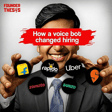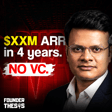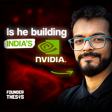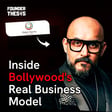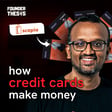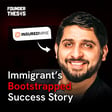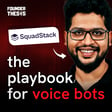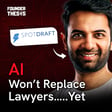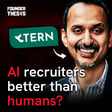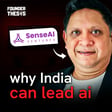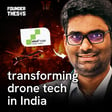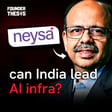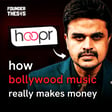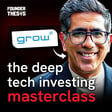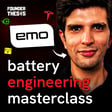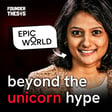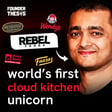Introduction to Amit Singh and His Ventures
00:00:00
Speaker
Hi, everyone. I'm Amit Singh. I'm founder of Misfits. Before this, I founded Shakil. Happy to be here without sharing.
Exploring Basic Human Needs in Transportation
00:00:20
Speaker
We talk about our basic needs as Roti Kapra or Makan or food, clothing and shelter. But I think there is also a fourth basic need and that is transportation. Within the transportation sector, one of the biggest market opportunities is in the daily office commute. The market of daily commuters is so massive that the government has invested tens of billions of dollars in building metro systems in various metro
From Shuttle to Chalo: A Journey of Growth
00:00:44
Speaker
and this is also the market that Shuttle was chasing. Shuttle raised more than $120 million to capture this market before the pandemic hit and they decided to get acquired by the travel tech unicorn Chalo. Amit Singh and his co-founder at Shuttle Deepanshu were early employees at Tabong and they decided to jump into entrepreneurship. The rest of their story is as unlikely as it is amazing. You will need to hear this episode to learn about an amazing slice of India's startup history.
00:01:12
Speaker
Stay tuned for Akshay's amazing conversation with Amit Singh and remember to subscribe to the Found a Thesis podcast on any audio streaming platform.
Amit's Transition from Engineering to Entrepreneurship
00:01:31
Speaker
So I would just, you know, at a very broad level, what's your origin story like, you know, the pre shuttle journey, which led up to what led up to you deciding to become an entrepreneur eventually, there might have been some dots which got connected and you became an entrepreneur. So just give me an overview of that pre entrepreneurship journey. Sure.
00:01:54
Speaker
So a lot of people go to engineering colleges. I grew up in an engineering college. My father was a professor at what is now NIT Alabak. And I never took that call that I want to be an engineer. It was almost assumed. I don't remember having that discussion or how I went through that decision. It was very organic. And when I went to IT Delhi,
00:02:21
Speaker
Somewhere, all this life, it was all about getting there. And I somehow stopped enjoying what I was waiting for. I didn't enjoy the whole engineering bit there. And it felt like I connected more with business. And it started with some humanities course there. I remember taking up an entrepreneurship course there.
00:02:46
Speaker
I remember the business world, that magazine that used to come, that used to be at five rupees at that time. And I would not miss a single edition of that. And that's how I got introduced to the whole business world. And I felt someday I would like to do it. But it seems like very logical.
00:03:10
Speaker
You know, if I go back, I was groomed in a very different way. My father was a professor and I remember we had this, what we call school.
00:03:21
Speaker
you know, event wherein we would put up stalls and would make some money. And when I came back home after that, and I said, I made so much money, I kind of, it wasn't received the way I thought it would be received. It was like, you should focus on studies, what is this year doing? And my dad was also a way, you know, kind of, in that generation wherein he would teach a lot of students elsewhere also, but he'll never take up any from them. So he would say, since I just focus on, you know, building a proper career,
00:03:51
Speaker
And business was not seen in the most perfect light in our family where everyone was either into education or into agriculture or maybe into medicine. This was not something which was very positive. I'm not that old, but somehow that was the setup that I grew up in.
00:04:11
Speaker
So there was a bit of a transition wherein I stopped liking engineering and started liking business. I liked the whole idea of what engineering was doing, but as a core job, I didn't enjoy. And the natural thing was, you know, kind of you would go and join a tech company and take it up from there. But another thing happened, you know, when I graduated, it was around the time of dot-com burst.
00:04:37
Speaker
And whatever we used to talk about technology was like kind of all those things were broke. Dreams were shattered and all. And I started hitting technology also. Actually, when I'm talking technology, I'm talking computer science and the way we call tech. And when I'm seeing engineering, I'm talking about the classical old engineering that I used to go up. So they may be confusing for some.
00:05:05
Speaker
So then, you know, kind of there's a bit of a decision point in my life. So what I said, okay, this technology is just a sham. Let me go back to the cold or old engineering. And I like the whole idea of mission building and, you know, like the idea of I was still an engineer. I joined a construction company and I kind of liked the impact, but I still didn't enjoy the role.
00:05:27
Speaker
So I changed my roles from an on-site role to bidding for projects, which was more commercial. So that's where I started liking that there is some dollar value in whatever we are doing. I wanted to be close to that.
00:05:42
Speaker
But very quickly, I realized that, you know, that is not the path because I need to be, you know, in those times, you know, the career provisions were not that obvious that, you know, you start and you will end up becoming. So the goal is that if you want to be a CEO, you want to be closer to the business side of things. So somewhere, I felt like, you know, I need to do an MBA to kind of shift that path. I went to XLRI.
00:06:07
Speaker
But by then I had fallen in love with Infra and I continued to be there, but on the commercial side of things. So I joined an Infra fund. And it was Access Private Equity, the investment, the fund arm of Access Bank. And we used to invest in Intra assets and Infra companies. Sorry, that set up, I really like that. There was this dollar part of it and there was this Infra part of it. I felt that it's all converging for me.
00:06:36
Speaker
And then I got, I really grew into it and then I grew out of it.
Gaining Experience at Jibong
00:06:42
Speaker
I want to start something of my own and I don't see myself as a contractor or someone, you know, kind of building toll roads and all. So, and then also too early in my life, I went into investments. I felt that I'm not really building like skills. I'm not building career skills. I'm not managing a big team. I'm not hiring people. I'm not, you know, really involved into this. It's more like, you know, taking one or two decisions in a quarter. What is that thing about?
00:07:11
Speaker
So, and then this realization that I wanted to start something on my own and neither private equity provided me with those skill sets nor infrastructure was the area wherein I see my shows, you know, I may like it in a different way, but I didn't want to build a company there.
00:07:29
Speaker
So again, this decision point came what next and somehow that was a big inflection point in my career because I got introduced to technology, the consumer tech that we call it. This is an iPhone's game and you know, I started reading about it and it all seemed very fascinating. And I decided that, you know, kind of which never happens likely in those times, it never used to happen that you know, you would leave private equity.
00:07:54
Speaker
and join a startup, but I did that. I moved from Mumbai to Gurgaon to join Jibong, which was getting started at that time. I took a pay cut because I thought I'll be here for six months and then I'll start something of my own. I was naive enough to feel that I would be good enough in that period.
00:08:20
Speaker
I ended up staying there for more than two years and I really enjoyed my stint there. And I picked up things everywhere, you know, kind of everything I did was new for me. And the team was kind of super motivated. It was self-selected team. It was pre-startups were cool times. And so anyone who was coming there was coming for their own personal reason that, you know, they want to do well there, not because salaries are good or it was more exciting, none of that.
00:08:50
Speaker
So that played out beautifully for me. And I ended up learning a lot there. I would say that in the previous 10 years of my life, whatever I would have learned, I learned more in two years there. And that changed everything. I was a very distant person before that. I was more like a classical career person looking for the next date. Here I started understanding consumer. I started understanding the user, the internet part of it.
00:09:21
Speaker
And if there was no Jabang, I don't think there would have been a shuttle. I met my co-founder Deepanshu at shuttle. Initial team came from. At Jabang. At Jabang. I met Deepanshu at Jabang. The initial team also came from there.
00:09:39
Speaker
But a lot of the things that we kind of how we approach the problem came from a lot of learnings came from there. But I had this thing that I want to start something and I felt that now I'm ready for that. But I didn't want to start in fashion because fashion I felt was a vanity that is scaled because from an engineering mindset, I felt that clothing is essential.
00:10:04
Speaker
But fashion is a vanity, you know, it's good to have, but it's not must have, and that somehow shows up when you try to sell fashion because you have to discount it to sell more. So again, that engineering mindset came up and I felt that
00:10:25
Speaker
Maybe we should solve a problem and the harder the problem and the wider that problem is. So we moved out of Jibong and we tried to start something and at that time the funding environment was not what it is today. So the default assumption was that we will not raise capital.
00:10:45
Speaker
And let's build something which can be built without much capital intrusion. So we thought that content is something that you can just build without. There's no matims to be moved there, so it should be cheaper. And the insight there was at Jabong, we were seeing that within six months, the transactions we were getting from mobile phones went from 5% to 20% in a matter of six months.
00:11:11
Speaker
It looks very, very obvious today, this is going to happen and all, but at that time, we felt that we have found an insight that this is changing. This was the early years of 3G, I guess. Yeah. So this was, I don't remember it was 3G, maybe 3G or 3G. It was 2014, March. One quick question. What were you doing exactly at Jabong?
00:11:37
Speaker
Yeah, Jawang is doing a bunch of things, you know, I didn't have a clear role. So the first year I started with improving some processes in the warehouse, then the returns piece, you know, kind of I picked up because you're getting lots of returns. So how do you kind of, in a very systematic manner, how can you approach that problem and reduce the returns that you're getting?
00:11:57
Speaker
then did process excellence at different places, costing, which was like my own thing, you know, from the past. So I got that. That was first year. Second year, I was building Chubong world, which was an international business, trying to cater to and arrive women, but selling ethnic wear because they have everything there. But ethnic wear is where their struggle is. And it started with
00:12:25
Speaker
daily ethnic wear, which is what Jawang had in its assortment. But very quickly we realized that that's not what they're willing to buy. That's not what they want. They wanted more like festival wear on a Diwali or India, India day or something. You would want to wear something different.
00:12:41
Speaker
So we ended up building the assortment also, going to Surat and all these places, trying to build an assortment of langars and all those sardines and stuff and trying to sell it in Jevong world. And while it was within Jevong, it was completely different. They started thinking we'll divert some traffic there, which we are getting in international traffic and we'll divert it there. That never happened. It was too inconsequential for the rest of the team to kind of go after it.
00:13:06
Speaker
we thought the assortment we'll be able to sell so that didn't work. We had to build a new assortment. So the entire product logistics, even international supply chain, and also kind of the whole marketing, digital marketing and all everything we ended up building our shares. The product was completely different. Deepanshi was building this with you. Yeah, Deepanshi was there. We were in the same team. So yeah, we were building it.
00:13:31
Speaker
And we built it, you know, kind of the punch in my salary, you were able to kind of break even also, you know, so it was a very nice experience. I remember some interesting things ahead of its time, right? Like international cross-border e-commerce. I mean, today someone like Temu has probably cracked cross-border e-commerce or like Shane has cracked cross-border e-commerce. But at that time, I guess even the logistical infra was not there to allow fast deliveries and all.
00:14:04
Speaker
This is not how we were seeing it. See what Temu is doing. They are doing very different products. They are leveraging on the power of China being the manufacturing hub of the world. We were talking about a very thin slice in it.
00:14:23
Speaker
time, it was not about faster delivery at all. See, you know, if you have to, what are the, it's, she businesses are always about what is alternative that the user has. So if you're in LA, if you're in, you know, in shape or New York, wherever, what choice do you have to buy a Langer?
00:14:40
Speaker
You can wear what you had, what you bought in your last visit to India, or you can buy something which is available online. A lot of sites were not really doing a good job. One or two were doing fine. So there was an offer. People were willing to wear 20 days, 30 days, all that. And there were no returns. We were shipped. So people were OK with that. So it was very counterintuitive. And sometimes people used to be amazed that, OK, you don't offer returns.
00:15:05
Speaker
You deliver in 20 days. You make money also. But obviously the scale was tiny. It was in consequential. Interesting. It didn't do much for Jibong. It didn't change anything for Jibong. But it gave us a lot of sense of belief that we can go out, build everything piece by piece. I don't think anyone would have given it to us to go and build it.
00:15:27
Speaker
It always looked like, oh, it's a small marginal thing. And then we would keep on adding one more layer, one more layer. Okay. Now we need to build our own product. We need to build our own assortment activity and just work fine for us. Okay. Understood. Yeah. So coming back to idea one.
00:15:43
Speaker
Yeah, so then, so when we moved, so we saw these transactions at Jibang also, as well as Jibang world was not, I think, I don't remember whether the mobile penetration was going up or not. But in Jibang, we saw the number of transactions you are getting from mobile was going like crazy. So we feel that if transactions are going that way, then the content should also follow that path.
00:16:06
Speaker
And maybe there is, and we were all consuming content on mobile, which was very, you know, parent also. But if you see the content that you consuming was not designed for mobile, it was designed for the web.
00:16:21
Speaker
And we were just consuming it in like, even if we were consuming it on Twitter, Twitter will throw a link, which will open up a full blown article. And then someone will render it well. So the rendering was getting solved, but the content was not designed to be consumed on the smartphone. The smartphones was also a little smaller than what they are today. So it looked like, you know, that's a classic place that the content should be created with mobile in mind.
00:16:50
Speaker
And we tried to go after it, but we had various citations, additional products we designed. Next our video.
00:17:01
Speaker
So mostly text, there was maybe a little bit of visual, meme kind of things. But so one was, we thought that, okay, Buzzfeed is there. Can we imagine Buzzfeed for the model and design it like that into work. Then we tried to kind of do some kind of show meme kind of things into work. Then, interestingly, we were doing something which we used to call impersonation network. It was like, you have
00:17:35
Speaker
But you have to leave that character for the entirety, right?
00:17:40
Speaker
what you are calling it Zorri, which is sorry but not sorry. For each post, you can pick up a different handle. So I can be Virat Kohli saying something, and then the next one I could be Anush, or I could be Rohit, or whoever. And some way the interesting conversations can get created. But every time we were doing that, we realized that
00:18:08
Speaker
We started for the wrong reason. We assume there's no captain. That's why we should do content, not because we are good at it or we are the creative folks that will trigger those things out. And we realize that we are engineers at heart and that's what we understand. So give us a problem, we'll solve it. But when we don't know what the problem is, we used to kind of end up going in circles. So we had various attempts, but none of them worked. And we eventually decided to kind of pull that, pull the flag. And then we started looking for what's an interesting problem to solve.
00:18:39
Speaker
And, uh, this is like, uh, you know, that's four, five of us, everyone's left their jobs. Nine months into this, nothing has happened and you don't know what to do next. And, uh, the punch was on his own as being salary for the other two. And I was definitely not earning.
00:18:55
Speaker
And my first born started going to school. My second born just happened. So it was not the most simplest of the times. But in my life, I had learned that when you want to do something, you shouldn't try to stack that, okay, first I'll do this, then I'll do this. Whatever it is, just take it head on. Otherwise, it never happens. So I just went after it.
00:19:22
Speaker
And, but there was a period where we didn't know what we'll do. And we just, because when we left job, we thought we knew what we'll do, but here it was without a job and, you know, with cash outflows and all.
Challenges in the Intercity Travel Model
00:19:35
Speaker
So I remember reading this article about blah, blah, car launching in India. And they were, this, this whole, you know, kind of peer to peer, right. And they were focusing on the intercity market.
00:19:49
Speaker
And they were launching with Delhi Jaipur, with the Jaipur Litfist coming in. I said, that's an interesting problem. That's a problem that is worth solving. Nobody needs to go to ISBTA to go to Jaipur. It's such a good way of doing it. And the experience is broken. We know that. We have done that better ourselves. But I was not sold on to the way they were doing it. They were trying to make it a true peer-to-peer classical play.
00:20:16
Speaker
And my learning was that supply has to be solved differently in India. It's not US or Europe where a lot of things are taken care of. So we thought that the idea is good, but let's have taxis on the supply side. So Enova is on the supply side.
00:20:34
Speaker
And on the demand side, we'll just acquire users the way anyone else would. And we'll start with one-way gaps. So we used to pay two ways when we are going to Jaipur. So at least half the cost we can help people save. But that is just to get things started, get the liquidity in place. And then we'll start sharing seeds in an hour.
00:20:56
Speaker
So I remember we were getting listed on Redbus, which didn't have a provision for Inova to go into the city at that point of time, you're pushing them. So we're doing all sorts of things. So the weight of product also, which was our own, but also we're trying to kind of ride on to the user base of Redbus and other such products which were helping users travel into the city. But the form factor was different, the supply model was different.
00:21:24
Speaker
And while we were doing this, somewhere the real issue was that while the problem could be there, but the usage is very erratic and infrequent. So I'm going to Jaipur, then next time I may not go to Jaipur, I may go to Lucknow. Or maybe even if I go to, I'll go there to Jaipur maybe after two months or three months. By then I would have forgotten that I used GoCabs, which is what we call them, to get there.
00:21:50
Speaker
So the user acquisition, you were acquiring a user and the LTV was just a transaction. So either you make money on the transaction, because every time you have to pretty much, you know, require the user. So somewhere at the core of it was the frequency of travel. And I found that
00:22:11
Speaker
to build a good business, to build a real solid business, the frequency of usage has to be very high. Only then people will install the app and add some background of Jibong from Jibong that, you know, the installation of mobile website and all those things, you know, how do you can. So, so that was one thing. But the initial assumption was that cities are sold for by Ola and Oban. But then, you know, in Jibong, I realized that, you know, kind of
00:22:38
Speaker
Whenever you drop the prices, the sales would go up. So I feel that the real way to grow a market is to operate at a lower price point, but it should not be subsidized by the investment dollars or something else.
00:22:53
Speaker
The offering should be designed such that it is operating at a lesser price point only. So while it was being sold at 7 rupees and 6 rupees and 8 rupees a kilometer at that point, we knew that it is a 20 or 15 rupees product, not less than that. We knew that very clearly.
00:23:16
Speaker
So they were subsidizing it basically over and over. Yeah, that was very apparent because taxis we had worked with, the novas we had worked with, we knew where the seat cost comes. And they were not even selling the seat, they were selling the entire cab to you for that period. So we felt that, and India is not a 20 rupee market.
00:23:34
Speaker
20 rupees or kilometer market. That's what a strong belief we had because in Jiavang, we knew how price-conscious we were. We launched 500 rupees shoes, which really did well. So we knew the price sensitivity of the market. So we said we have to launch a three rupee product, three rupees a kilometer product. And then, you know, we thought, you know us, and then slowly we'll graduate to airport avenues, which were 12 seat ups.
00:24:00
Speaker
And we started with a use case, which is, we said that, okay, I was talking about the frequency of the usage. So we said that anything that has, what is it that has the highest frequency of usage?
Success with Shuttle Service Launch
00:24:13
Speaker
And it should talk about only mobility. It is office commute. It's almost like a toothbrush use case. You use it twice and you use it every day, 20 times in a month or more, that kind of a thing.
00:24:23
Speaker
So we said, okay, I used to stay on Sonar Road at Gurgaon and we used to work out of this small co-working, this old co-working was cool at Sector 24, which was next to Huda City Centre. And every day I would see people coming the other way, like from Huda City Centre towards where I stay, they would come and work in these offices, in these shared autos, lot of these shared autos, but I was full of these people.
00:24:49
Speaker
And I said, you know, let's do last mile only. Let's do Huda city center to Shona road. Not too much thought about it. One more thing had happened in this entire year before that we tried to build a lot of products and none of them worked. Even the intercity product was completely built. And at some point we dropped it. So we are way clear that we are not going to build product. Now we first start the business and then build the product. So product first mindset was thrown out of the way.
00:25:19
Speaker
So overnight, the Panchu just put together some code which would say, some to book. That's it. There's no payment, nothing. That's it. And we would go to Kudaswati Centre and ask people to just try this. And we had a few InnoWatch. And people will
00:25:37
Speaker
Just, you know, we will charge them something similar to a shared auto and shared auto. The thing was you have to change it. So you would pay 10 rupees twice and your cost would be 20. We said we'll charge you 20, but this is AC. So in terms, it was a no brainer for anyone who would come there. And we got a few people and we came back to our office.
00:25:59
Speaker
In Jawang, we did one thing that whenever we used to get those orders to international business, because the timing was kind of off, like when it was night for us, it was day for them and all that. So our phones will ring that we've got an order, because when you start, you just get one order or two orders a day and all. So you need to know, otherwise it will not realize that you have to function that order. So we did the same thing here also. Whenever we get a booking, our phones will ring.
00:26:29
Speaker
And so in the morning we got a few people from, I remember there were only two people, we got them from Huda city center to Sunarod and we came back to our office and started working. It was just trying to feel, we're not even launching launch, we're just trying to see if there were just few pamphlets and we're working on that. Interestingly, in the evening the phone rang.
00:26:52
Speaker
And it was like, you know, we didn't have monetization for one year. And here we were getting a repeat. We had not anticipated that, but somehow we managed to kind of get those people in. But what we realized that those two people came back and they got five of their friends along with them. Now, where do you see that happening, right? This was day one, evening. We had repeat, we had referral, we had monetization.
00:27:23
Speaker
I said we are on to something like this is like, it is as small, but you will see in startups, another interesting thing is that you really don't have data to begin with. But you have to go with reading indicators, early signals. Why are people coming? They could have forgotten us, you know? And why are they getting someone else? Because, you know, someone said, oh, it's, you know, why take a shoot or to just, you know, take this? And someone felt good about, you know, telling about us.
00:27:53
Speaker
So we said there is something here. We should really kind of double down on this. By that time, another backstory is that we had raised some money for the intercity business. We didn't have the company incorporated, but the money was committed about a crore.
00:28:09
Speaker
And this is after one year we didn't raise anything. So when we were trying this, I spoke to the angels also that we are trying this. So nobody said, you know, don't try. But people said, you know, why we carry money? So we should not forget that.
00:28:32
Speaker
So we came back and we said, there's nothing going back to that. This is what it is. We never had that feeling for a year. We are waiting for that feeling that someone wants what we are now building. And this is the first time we are getting it. There is no way we'll do anything else. So we, we said, this is what we are doing. It's really interesting. We were like, also kind of sure.
00:28:55
Speaker
talking to someone to raise a slight institutional round also. So they were quite keen, you know, they had a couple of conversations. It was all very nice for the intercity thing. And then we had the final call on what we thought was a final call. And suddenly we said, no, we are not doing that. We are doing this.
00:29:14
Speaker
And people cannot take it. What kind of erratic people are these? Sometimes they say this, sometimes they say that. And all that was happening, but we said, this is it. And it's so funny that, so this is, so April 1st, 2014 was the first day in that content play. In January of 2015 is when we started the intercity thing.
00:29:36
Speaker
And these are the dates, a few dates I remember. April 6th of 2015 is when we went to Vodas City Centre to get those two people in the morning. No, no. It's when we decided that we'll do this. We'll try to launch this. At night, April 7th, the Pancho built whatever it is. April 8th, we went to Vodas City Centre to launch it. Before the end of the month, we had a term sheet from Sikova.
Navigating Competition and Scaling Challenges
00:30:05
Speaker
happened. And if I now try to go back, I was thinking about starting something in 2002 also. I didn't know what to do. In 11, I tried to do a few things when I was in private equity. Nothing worked. In 12, I thought I'll be here for a couple of, you know, five, six months at Zhubang and I'll do something.
00:30:24
Speaker
Then we actually did something, had various iterations, none of that worked. The first iteration didn't work. And suddenly we had this. And you know what the metric, what history we had, we had two weeks of write data, two weeks, just 10 working days for us. And every day we were growing.
00:30:45
Speaker
some nine rides on day one, which is two people in the morning, those two people back and five more of their trains, nine rides. So on the 10th day, we had a hundred rides. We crossed a hundred on the 10th day. Amazing. And it was this, and everyone was repeating. Nobody was opting. They were just coming. And this, this is one chart. And then, you know, a lot of people said, no, but she said, yes.
00:31:12
Speaker
Probably it was more about that feeling, you know, kind of, there is something here. And yeah, yeah, that's, that's how it all got started. I obviously, we loved it. It was huge, you know, kind of, there's no, you know, when I look back, I think, you know, it was the more likely scenario was that we shouldn't have got money. The more likely scenario was that those two guys wouldn't have bothered about us again.
00:31:37
Speaker
So the more likely scenario was that we wouldn't have been tied this would have been done. We would have just tied the intercity that didn't work and you'd have opted out or we would have just shut shop after the content break. All those were the more likely scenarios. This was not something I would have dreamt of.
00:31:56
Speaker
You know, Kunal Shah has that maximum of 4x better that if you create something which is 4x better, I mean, my customers don't switch back to the other option than I think it was about Zomato that he gave. Yeah, Delta 4.
00:32:09
Speaker
Yeah. So you essentially created something like that. And again, while you say it's luck, but you manufactured that luck because you kept trying different ideas and you kept talking to investors. So I'll tell you why. See, now the thing about it, we started, we got those hundred rides. The money also came in, we grew very fast. And what happened was very quickly, we didn't do any PR about the capital raise and none of that.
00:32:37
Speaker
But very quickly, whatever we were doing, people started replicating it. There were a bunch of startups in Kolkata itself and other cities also. Everyone liked Sonawuda, which had, there's nothing great about Sonawuda, it's just that where I stayed and where I work. But they're like five companies or maybe three companies trying to do that. Ola Nowich wanted to do the same route. Like a Mumbai company, headquartered in, you know, a company that started in Mumbai, headquartered in Bangalore, launching Sonawuda where I stayed.
00:33:04
Speaker
So there's like, it was a crazy time, right? So what we spent was that, you know, there's nothing like we are first to it. There's no window that we are getting to kind of play it even while we are quiet. So we had to, you know, I just think that we had to outrun them. And it's not like 10%, 15% ahead, we have to lap them. And we said that everyone is, you know, doing 200, 200, 400 rights, and they will get 2000, 2000 rights, we have to get 10,000 rights.
00:33:34
Speaker
whatever that meant. So we went all out. We went all out to a to 10,000 rides so that we can say that we are at 10,000 and they are at, they're not one month behind us. They are at a different scale altogether. So we went to 10,000 rides just for show now who does city center.
00:33:55
Speaker
So we launched more roads. The idea was very simple that, you know, very quickly we can get to 10 roads and each route can give us 1000 rides or something like that. So we get to by September, we were, we had 10,000 rides. And you were acquiring customers through feet on street, like outside the metro station, somebody would say, try this. Okay. Yeah. The good thing was that repeat was very high and referral was very high.
00:34:21
Speaker
But initially the buses were not branded, none of that was there. So it was these two buses. You shifted two buses also very quickly. I'm calling it a bushel, but it was like a 12-seater, we were at 12.2 and we were beginning to move towards 24-seater tempo travelers. Okay. And then Hola launched.
00:34:40
Speaker
Uh, see the way we are going, we're running out of capital and, uh, we started raising for the next round and all I had this big news and take crunch that they will put $50 million into this category. Oh man. And they would launch this. Uh, so now that they will go after our lives, uh, it was very interesting those days, you know, kind of, uh, it's just memories now, but, uh, you could use a shuttle boarding pass, as you used to call it to write an Ola shuttle then.
00:35:11
Speaker
because they wanted our customers. So even if you're booked here, you can board there. So that is how, you know, all that we shot. And we got to 10,000. The timing was not good. There was no capital that was easily available.
00:35:30
Speaker
Because you would be losing money on every ride. Absolutely. It was a shit business in some sense. It was growing crazy. It was not making sense. Why was it not making sense? The ticket price was too low? Or you were spending on customer acquisition, like your feet on Streetforce and all? A bunch of those things were there. See, what we realized was in the absence of an alternative, it was great.
00:35:59
Speaker
But when a bunch of other companies are doing the same thing, there is no loyalty here.
00:36:04
Speaker
So on one day they will board your bus, on another they will build us. And then this bike sharing, bike taxi was coming up, so someone will take. All that was not there when we started, right? All that started happening around much later. So suddenly, for the city centre, it was like that war zone where all the mobility companies have to be there. And I'm just using that as an example, it was happening at all those metro stations. And
00:36:31
Speaker
What we realized that we have to go towards bigger and bigger buses to make the maths work out. And in fact, there's an interesting backstory there that we want to try to acquire all our operators on our buses also. And we lost more than a hundred of our operators. They were paying them more and so they were happily going. And we let that happen to us because we wanted to move from 12-seater to 24-seaters.
00:36:58
Speaker
because the economics was so much better. So in a way we had to wait for their notice period and all those things. We didn't have to do all that because all that supply went away on its own. And we very quickly had our average seater increased. The economics went better.
00:37:14
Speaker
But this was something, you know, it became very territorial also at some level, like where your bus is parked would tell you whether the customer is like, it's the way, you know, not mobility, the transportation is run, you know, it's very territorial. So it started giving you those vibes. And that's not what I wanted to build, you know, at some level. So we're trying to figure out, you know, there's too much friction and there are too many of those things. Is there something better we can do to this?
00:37:43
Speaker
So what we felt was, and some of these things are overlapping, so my, you know, kind of the realizations came earlier and now I'm talking about it, so it may look like. So we said that why not pick people from their homes? When they're, they're not starting their journey from what I've already said. So they're starting somewhere in Faridabad and Ghaziabad and Noida and Dvaraka and all the spaces.
00:38:08
Speaker
At that time, we had 12-seater buses only. So we piloted this thing called N10. So it's a 12-seater bus. If we fill it with 10 people, we'll make money. That is where the maths was. So we called it N10. So when it is only 10-seater, even Shava, reasonable sized condo or a small locality, you can get 10 people coming from Paridabad to Gurgaon, you know, that kind of thing. So we started like that.
00:38:34
Speaker
And, uh, it was a decent offering because, you know, almost taxi experience, uh, at bus prices shorter. Yeah. I mean, you have no guarantee of a seat on the Metro. You'll typically go standing and especially during the office peak hours. So here you're sitting in comfort.
00:38:51
Speaker
and AC and all that, it was great. From a user perspective, it was great offering, but then few realizations happened. One was that morning time for everyone is pretty much in sync. Everyone wants to be in office around in a shorter window of 9.30 to 10.30. But evening, someone is leaving at 4, 5, 6, 7, 8, 9. It's much bigger span, much longer span. So while in the morning from that condo while 12-seater was fine, in the evening, people wanted more choices. Flexibility.
00:39:22
Speaker
So the only way evening can be accommodated was that you have at least four slots. So we ended up having four, so that while we thought this should catchment for 10, it needed to be a catchment for 40. And then meanwhile, we moved from 12 seaters to 24 seaters in this journey, so that 40 almost became 80.
00:39:44
Speaker
So while everything was fine, the catchment was not big enough to serve this because it was designed for internet and it became somewhat, say, you're trying to get an IT out of it. But still, this had higher intentions and a lot of other
Improving Customer Experience and Retention
00:40:03
Speaker
things. We were struggling for growth here in some sense because the small pockets were there.
00:40:08
Speaker
But retention was really great. People were loving it like much, much more. It was not territorial. People were buying subscriptions. We introduced subscriptions by then. So people were very happy to buy subscription. And the good thing about subscription is that you have paid for next 30 days or 20 days or whatever. So on a given day, if someone is giving you a sweet pass, you have already paid for it. So you're not looking for.
00:40:27
Speaker
that she writes, you're not looking elsewhere. So acquisition by the competition was a lot harder. And we kind of thinking, you know, and we are like thinking ahead and not people are doing what we were doing earlier, and we were thinking applying and such there.
00:40:40
Speaker
So this, and there was a time when this seems to be working in this friend, like, okay, we'll continue to do this. One question quickly. How did you get data of which condos to start this from intuitively? Like, or like, was there some source of data? See, I think, uh, that's what, you know, that's how I like to think, uh, the obvious, the initial things are very obvious, like which are the big routes in a city anyone and everyone would know.
00:41:11
Speaker
And it's only when you want to kind of go towards, want to go further, that's when the data becomes a problem. Early ones are like, everyone knows in them, in the market. Then we did some studies, our shares, later it was an interesting problem and I can talk about how we solve it, but sure that was not the problem. These are very obvious rules. Now we got to 18,000 rights, I remember, and, uh,
00:41:36
Speaker
By then, it was very clear that the short routes, we used to call them corridors. This was intense, that was corridors. It was very clear that short routes don't work, especially in a territorial environment when there are multiple companies competing for it. And even the maths, the economics was also very hard because one side was always empty, like one way you'll go and the utilization of the vehicle was not enough. So all those things would come through.
00:42:03
Speaker
So we took a very hard call that we would shut down all these corridors. And that's why I'm saying, you know, we got money on that and we shut down, you know, less than a year into that business. And that was 75% of our business. We went down from $18,000 to $4,500.
00:42:23
Speaker
in no time. And there's a lot of resistance in the team also. We worked very hard to get there and we celebrated all those things. There was things we could say that, okay, this is what is working. Let's continue doing that.
00:42:36
Speaker
And there's people said that, okay, if we move out, then owner will hit that market and all that. I said, if it is not working for us, it'll not work for them also. Let them take that market, which is not working, or they just figured out something and we'll also launch on it. So, but it turned out to be a good decision. We moved out a few months later, I think we'll also, you know, moved out of that market. And I remember this because we were dressed in between, we had raised 20 million dollars. Uh,
00:43:05
Speaker
Wow. And Lightspeed led that round. This was like within a year of starting. It happened. But it was a very tough round. It looked like things were falling into a lap. It was a very tough round. Everyone was saying no. People were asking the economics and we had no control. It was, as I said, it was a shitty business because the economics were not good.
00:43:33
Speaker
It was growing fast and what we thought was PMF or adoption was adoption at a particular price point. You charge 50 rupees and people start thinking differently. 50 rupees or 40 rupees is what you should have charged.
00:43:48
Speaker
And we could, you know, we could have over time taken it to that, but in the face of competition, it was just not. So there's no point to run it at 40 rupees when someone else is running it as 20 rupees. And there was no, no point to run it at 20 rupees also. So it kind of became that kind of a thing. When you cut down the last mile business, this was after fundraise.
00:44:12
Speaker
So yeah, it was after and before I would say because when we raised $20 million, we didn't know we shut it down. We were still fighting for it because that happened in December. I remember it was around holy or after holy. There's another fund which was wanting to put in $7 million after that $20 million at the same price.
00:44:34
Speaker
They were, they were coming in at the same, in the same round, but someone moved in early, they got their ICD laid and all. So, and by then we moved from 10,000 to 17,000. They said, we can come at the same price and you know, but we would want to come in and all that.
00:44:49
Speaker
And again, same thing happened for with me, like what happened with one more time that we shut down, uh, these mid roots, uh, same five percent of the business only we are from 18,000. It looks both look small now, but, uh, at that time it looked like some 18,000. We are now we're like 40,000 and all the lapping thing I was talking about here, as we were as small as anyone else, why, you know, spend having spent more capital into it.
00:45:17
Speaker
So yeah, and then, you know, that IC also said, you know, we can't, you know, underwrite this, you know, we were documenting certain scale, you don't have that scale. So we didn't get that round, that off capital, but it was fine, you know, we had enough to kind of shurry build it, so to say.
00:45:34
Speaker
And I guess this was also like a peak time, like this 2015 when you raised was like the peak of funding before it kind of crashed. The first one was that, you know, first one was exactly that. And that's why we never felt that, you know, capital raises a problem. Second was very tough. You know, I remember Bajil who was heading like speed then, I remember meeting him and
00:46:00
Speaker
Then he called me again, then he called me again. And he's a very different kind of a person. He would start the conversation from where the last conversation would end, would have ended. So it'd go back to his notes open that time. Last time you were saying this, I want to double click on it. Every conversation would start on some double click. And I remember it was just like going on and on, like in a matter of two, three weeks or whatever, you would have, I would have met him seven times. And the seventh time I remember he asked me something and I said, I have no idea.
00:46:28
Speaker
I'm completely out of depth here. Maybe we will shut it out. Maybe we will not. And that's when those conversations ended. I thought actually the discussion has ended, but he wanted to see how far can he take me in that thought process. And then that commitment came. Sikho was very, very bullish on us. So they kind of co-led the round.
00:46:51
Speaker
and time's internet came in. So all that was fine. But the market has completely changed. I remember Tiger talking to me about economics when we were just six months old. I realized that if we went with a certain assumption set and the market has changed, our assumptions need to change too. And that's why we pushed hard to close those rounds, those routes which were shorter rounds.
00:47:19
Speaker
All this happened and this intent was working somewhat, and we were trying to scale that, but we knew that there was this fundamental problem there also. So we are not out of the woods. And it's like, it's much harder when you want to kind of, you know, iterate at scale. So while it looks like money worked in our favor, that capital,
00:47:44
Speaker
And I'm sure, you know, I'm saying it because we had capital. If we didn't have capital, we would probably not exist. So it's counterfactual in a way. But I do feel that you need capital to kind of prove certain things. But if you scale without proving, then it becomes so much harder to change. We had a team which was gearing for 50,000 rights.
00:48:09
Speaker
which was dreaming about planning for executing on and we had four and a half thousand. How do you kind of marry the two, you know, how do you convince people? Is it working? Is it not working? Still keep them motivated. All that, right? And then you have raised so much capital. So that burden is also on you to kind of generate returns on that. So all that is there.
00:48:29
Speaker
So it was much harder then. And, you know, kind of we kept on trying things and then, you know, story. I'm sure that's what we would have sugar that out at smaller scale also, but, you know, whatever it is, we had this problem was bigger, relatively bigger scale at that time. And we had to figure it out at that scale. So what we, you know, started thinking like the way I kind of broke it down was that you should think about commute.
00:48:55
Speaker
They are used to call last mile and all that. But then I said, OK, there's office mile, which is your last. It should transit up to your office. There's a mile before that, which is your mid mile, which is typically in a UTC bus or a metro or a local or somewhere. And then there is first mile, which is home mile. So we didn't call it last mile and first mile because they were revert in the evening. What you're calling first mile is last mile. So call it home mile, mid mile, and office mile.
00:49:25
Speaker
Offices are typically high concentration areas. So density and, you know, catchment is not a problem there. And mid-while is the most painful for the user. Last-while is the most expensive for the user. Or the first middle, home line is the most expensive for the user. From your home to a metro station, it's always 50 rupees, not less.
00:49:49
Speaker
Yeah, there's no shared service. On the other side, they shared. So the moment you break it down, you will see that these are very different patterns at play. So we were, we said, okay, let's not do intense the way we were doing. We were doing, we were doing all three lines of his mind, home mind, mid mind and office mind. And we said that, okay, let's skip the home mind.
00:50:13
Speaker
We'll pick people from a transit hub, but not the one which is closest to their office, but the one which is closest to their home. So think of it like we were requiring people at Vaishali. We were requiring them at Cyber City, but they were boarding us in the morning at Vaishali.
Innovations and Market Adaptations in Shuttle
00:50:30
Speaker
Next to the metro station, they'll come to the metro station, not get into the metro, board a shuttle.
00:50:36
Speaker
and come all the way to their office. This, we could get the right kind of density. And we call these lines. So from corridors, which were the office mile, to entrance, which were all mile, to lines, which were just everything but the home line. And that really is scaled. It's that sweet spot wherein you're solving for the pinpoint, which is the longest journey. You're solving for the last mile also, the office mile also. But you are skipping that.
00:51:06
Speaker
And then as we grew along, we started, as we get more density, more users on a certain route, we'll extend the route to something closer to there. Not exactly the whole, but closer to there, and we fork the routes. So increasingly we'll keep getting closer to you, but after we have demand.
00:51:24
Speaker
So the end goal was we get to enter, but once we have demand, we and the customers will tell us where they are coming from. So we can accordingly design the routes rather than imagining what you're talking about. So once you have adoption, then last night was more of a data problem, which was not easy to solve. So yeah, so think about it, you know, the engines came for intercity.
00:51:48
Speaker
We shut that business down. Sequo came for corridors. We shut that business down. Lightspeed came for intents. We shut that business down at some point, right? So it was just we had capital, so you got more shots at it. And the market also kind of turned south at that time. 2016, there was hardly any fundraisers happening. So that didn't create the competitors that we had. Most of them kind of got stopped. They could have done better than us.
00:52:17
Speaker
One also realized that they became non-core and they were doing food panda, food cafe and other things at that time. So they kind of didn't scale this beyond a point. And we ended up doing something altogether different, which is what we scaled.
00:52:38
Speaker
Amazing. It was luck, right? I see where you're coming from. Amazing. The timing was just right. Yeah. And interestingly, what happened was there's one competitor which had the same capital that early on that we had. Which one was it? Zipco. So the first round, they had a little bit similar rounds that happened very close to us.
00:53:06
Speaker
And when Ola tried to come and make it difficult for us to become a big company and the funding environment went south, it hurt them the most because we were the leaders and we got capital probably because we were way ahead of anyone else. Ola, it was just a decision one day that we want to do this.
00:53:32
Speaker
So there were two players. There's no place for third player in a market when you know, kind of shoved. So as a company, they continued for a long time and they did very well, but capital was not kind to them. I think it no longer exists, right? Zipco? Yeah, yeah. Okay. They pivoted their model. I can see they've raised more than $50 million lifetime amount that they've raised.
00:54:01
Speaker
So I don't know about that, but they sold to Ashel. And Ashel group landed into its own set of problems. Okay. Out of that 50 million, 43 million is the amount which Ashel put in, which was essentially the acquisition. Okay. So tell me the journey from there. So once you discovered this,
00:54:28
Speaker
eliminate the home mile and do mid-mile, office mile. How did that scale up? What kind of numbers did you see? And you know, what was. Yeah. And so I think while it looks like we were like very crazy trying to, there were some very sensible things we were doing, which is like we were only in Delhi for the longest period.
00:54:47
Speaker
not trying to kind of with 20 million dollars in bag you would say okay let's launch Bangalore let's launch Mumbai and all that we did none of that we felt that it's a network business and if we really do it well we get the right to play in other markets but we have to really solve it well here and if you see at each iteration while you know I'm talking about these three four from intercity to this is this
00:55:10
Speaker
There are like a bunch of, these are almost like pivots. You can tell, maybe many pivots. But in terms of hydration, there were tons of things that were happening. On each dimension, we were watching the form factor, from Inovas to 12-seaters to 24-seaters to 28-seaters to eventually 56-seaters. We even talked about, can we get double deckers in Delhi? Can we get articulated buses in Delhi? We're thinking on those lines, how does it?
00:55:36
Speaker
What can we do to get people to their workplaces in the most comfortable manner, in the most painless manner, at the least price possible without subsidizing it ourselves? So that is how we are kind of articulating the following. Bus happened to be the answer to it. It was not like we wanted, we started off, okay, this is a bus company, let's build it. It was just a means to an end to get to that three rupees a kilometer price point, which we had, you know, a target shortage.
00:56:04
Speaker
So then they were like, you know, it started becoming a little bit boring business. It was too exciting, too many things. And it's important for a business to become boring, only then it's making sense because
00:56:19
Speaker
Something other keeps pulling you here and there. That's not what you want. So we knew what are these different workflows that we are working on. What are these different projects that we are working on, different teams. Everyone knew what their role is. So we started going deeper into those problems. By when did it become a boring business by which year?
00:56:44
Speaker
See the problem with transportation is that it never becomes a boring business. So our model started becoming more predictable, but then one fine day you would have, uh,
00:56:54
Speaker
What was that Ram Rahim protest and suddenly the buses will get burnt out. None of our buses got burnt out but all that would happen. There will be some covered thing happening where the routes will get diverted. A new flyover will come and suddenly Google ETA is all wonky and you need to know, suddenly the buses are reaching much faster and people are missing buses.
00:57:16
Speaker
Something or the other kind of will keep happening. So it's never boring in that sense. But we started figuring on a normal day, we are getting more and more predictable. People were buying their passes, people were renewing their passes. We were increasing the prices and people were absorbing that. The moment we increase the prices, people will go away.
00:57:37
Speaker
And then some percentage people will leave, but they will come back. So we know that there is stickiness. They don't like to pay more for something that's not paying less. But all that, we figured out how to launch new roads. ETA was a big, big thing. See, Google ETA is not for buses. It's for cars. Now it is for two wheels by the time it was only for cars.
00:57:59
Speaker
It's a very different form factor trying to kind of navigate. In certain places, the buses are not allowed. They have to take a different route. So Google is all not geared up for that. Plus, because we are running shuttles, we knew there's a shuttle that is 15 minutes ahead of this shuttle. And there's a shuttle which is 15 minutes behind this.
00:58:20
Speaker
So we had more data about how that route is performing on that given day, which was not getting captured by Google because it was generic data, right? It was not giving ETA for shuttle. We know there's a bus stop, and there are so many customers who are waiting for us on that bus stop. So if it is one person, then it should wait for this much time. If it is five, it will wait for this much. If there's no one today, so it will not wait today. So all that information we had, which was not somewhere captured in the Google ETA, so we ended up building our own ETA.
00:58:50
Speaker
And our accuracy went up like from 60 or 65 or 70% maybe to 90% 70% the experience changed altogether.
00:59:02
Speaker
There are other things like, you know, kind of, you know, I can go on and on on these things, but like technology has its own limitations, like GPS has a least count of about 20 meters, at least at that time it had. So the GPS is only accurate to 20 meters. So when you're going
00:59:21
Speaker
When you're taking nowhere, you can always call a driver. You can talk. In a bus, you cannot call the driver. If you're going to Starbucks, you can just see Starbucks. If it is 20 meters here and there, you'll see it. But here, there's a bus stop, which is not a bus stop. It's just a point in the map. And there is no bus. There is no stop.
00:59:42
Speaker
and you have to be there and basically for the first time user, how do you kind of know that you have, even if you are at the right place, how do you know you're at the right place? And you could be 20 meters here because of the discount and the driver missed of 20 meters on the other side. So this is 40 meters and when the bus is big and all that, but when it comes, it comes so fast, chances are you'll miss it.
01:00:06
Speaker
And when you miss it, you will not come and say that you missed the bus. You'll say the bus didn't come. How bus left early. So the customer, you know, kind of will talk like that. So how do you address that?
01:00:17
Speaker
So this is where the real world shakes hands with the digital world, or the digital world shakes hands with the real world. These are very nuanced things. Nobody is solving this. It is not Google's problem. It is nobody else's problem. It is not AWS's problem. So we have to kind of figure out answers to that. So we'll put up photographs of these stops, and they'll try to scale it. Then someone would have, you know,
01:00:41
Speaker
you would put up a photograph and you thought this is GPS and you put a photograph there. But actually over a period, both the users and the drivers somewhere had an implicit assumption that the bus stop is not this, but it is this. We assume the bus stop is this, but everyone kind of decided it is elsewhere. All photographs could be here or we could have put a photograph there and it was behind that was a hoarding. Then the hoarding changed. A new customer comes and he's looking for that hoarding. That hoarding doesn't exist.
01:01:09
Speaker
So while you're trying to use technology, there's other things also. So it was a lot of fun because of that. It never became boring. And what really got us going was that it was huge consumer love for the product.
01:01:24
Speaker
Huge. People would just swear by it. Even today, people say, I keep waiting. I used to use shuttle in the evening. My evening time was about what I use my shuttle, where I've booked, and all that. So we changed the way the city was traveling to an extent. And that was the most heartening part of all this. Just lots of people would come and tell me that this is something they were also thinking of doing. Because this was such an on-the-face problem.
Personal Insights and Business Solutions
01:01:54
Speaker
And the reason we could build it was not, you know, yes, we would talk to consumers, we'll do all those ground zero event sharing, we'll go, the entire company will go on a different, you know, bus stops and talk to customers and, you know, ride back with them and all that we do. But I don't think that changed things for us. The reason we could build it was because it was rooted in our own experiences.
01:02:17
Speaker
Like when I was in Mumbai, it was very interesting. I used to stay at Shiva. I used to stay at Bhavadevi. My friend used to stay at Shubhaji Park. And I tried various things. I would take up local in the morning. It was very painful. I'll take Kali Pilip. It was in 2007, 2008, in those days.
01:02:36
Speaker
I remember being very humid. I would just be all sweaty by the time I reached the element point. It doesn't work. So, you know, you're looking for cool caps. The blue caps were not always available and they were very expensive. So how are you going to deal with this? So there's this AC bus that used to go from near my place. It would start much earlier, but it would cross my place.
01:02:59
Speaker
But it was like 40 minute sequence. Every 40 minutes there would be one. So you can only pick that one or you're lost. So my shrink would bought it from Shivaji Park and will give me a missed call.
01:03:13
Speaker
And the moment I get a missed call, I know it will take five minutes. I'll take two, three minutes to get to the bus stop. I'll start from it. So in a way that was my tracker. So I understood the value of tracking. That was my ETA. I understood the value. I really felt the value. Nobody had to tell me that. And by trying other things, I knew the value of EC. And when we would get into the bus,
01:03:38
Speaker
We would, you know, when, when you do that every day and the set of people who come are also become like same 40 minutes frequency. The only set of people don't want to wait for it. So it is bunch of people who are coming every day and you start recognizing those people. So we would know the people who would get down at worldly, they're going to just bank or some other place. And we would stand in front of them.
01:04:04
Speaker
because we know they will get done and we will get that sheet. So we knew the value of seat. So what was shuttle at some level? It was pick up from close to your home, drop to your office in an AC vehicle with a comfortable seat while you can track and you know.
01:04:19
Speaker
Then we added layers on it. We knew the frequency was a problem there. That's why we had to do this. So 40 minutes, we brought it down to 10, seven minutes. So then we enabled people to kind of reschedule. You can go to other bars, you can flip to the other bars, and we'll manage that. There's nothing, no cost on you and all that. So it was very intuitive. And that's why every time I have tried to do something that was not intuitive, it was not. The content thing was not at all intuitive to me.
01:04:47
Speaker
It's not that we didn't work hard there. It just didn't work out for us. Intercity? You didn't understand the customer team. See, understanding is not difficult to build. Understanding we can all build. I think I'm talking about something more subtle. It's the nuance. It's a feeling. Do you feel that? Because then you are in complete control. You're designing it for yourself at that level.
01:05:13
Speaker
So in the city, when I travel in the city, but not to the extent that I started feeling it, I understood that business at some level, right? But I didn't feel it that strongly. So every, this has been like forever, wherever I've tried to do things, I've kind of never worked for me when I tried to do something which is non-intuitive, which is not truly intuitive to me.
01:05:33
Speaker
And whenever I have tried to build a product before, before, and then launch. And not every business works like this. If I start a gaming company, I have to build a game, design a game, and all that. So I'm not saying this applies everywhere. But in my life, one side, I would rather launch without product, if I can. And then product was a catch-up. So when that happens, you'll always know what to build. You don't have to imagine.
01:05:59
Speaker
Customers are telling you it's all visible. ETA is off. Buses are stopping elsewhere. Some days they are reaching faster. Some days they're reaching late. All that is like, I wouldn't stop at that point. I wouldn't even start at the right place. So the problems are out there. It's not a creative zone. It's there, you know? And then you just have to kind of, and they can, product always have, I've seen that most solutions are there. They exist. It's about, do we know what problem to solve? In content, I didn't know what problem to solve. Here, we knew, and that's why we could build it.
01:06:29
Speaker
Amazing, amazing. So 2018 is when you raised your next round. What was the business like by then? How many rides were you doing? And was it still Delhi-based? No, so we had launched Kolkata and that is also an interesting story because Ola was exiting this business.
Expansion Strategies and Challenges
01:06:48
Speaker
So we were only in Delhi and they had shut down Delhi because we were pretty strong in Delhi, but they had launched a bunch of other big cities.
01:06:56
Speaker
And while they could exit all the shati when they wanted to, Kolkatai cannot exit like that. Their drivers, their operators, they will not let you suddenly disappear. So they had a problem. There is a very high importance of labor rights. So now when they were moving, we said the customer is there.
01:07:20
Speaker
So the supply is there, the demand is there, and the model we know anyway. So when they were moving out, we just went in. It was very opportunistic. And we didn't have to build it from scratch, so we were able to kind of very quickly transition those folks into our fold. So it was not that we were looking to... So I always felt that
01:07:40
Speaker
Growth is, you have to grow, but where do you want to grow? Growth could be that in the same bus, you're getting more users. That's great because your occupancy goes up, your margins go up. Or on the same route, there are more buses because then your frequency goes up, the offering quality goes up, it becomes better for the users. Or you could fork the route, which means you're getting closer to the customer's homes. That's also better. So let's try to grow there. Or even if you do another route,
01:08:09
Speaker
That's also fine because the network affects people, same office, people are talking about, oh, your road is also noise, you can go there and all that. So we were seeing all those values. Actually, we were sticking to one city. And then we started putting the branding of buses also with shuttle and all that. So the growth started picking up very strongly after that, because now people know what is happening. And we became a discussion point in the evening, people just run for their shuttles from a meeting. So people get to know, okay, there's something called shuttling. All that started happening.
01:08:38
Speaker
So I think we had launched Kolkata. Maybe we would have launched Hyderabad also because there's a small company there. They were getting a co-hired by Kareem in Dubai to launch Kareem bus.
01:08:52
Speaker
And again, we said that, OK, we can pay you for your CAC, whatever users you have. So we acquired them almost like with pocket money. We acquired them. And we said, we'll just pay for CAC. Otherwise, we don't want to launch today. So we had that negotiating power at that point. That's how we launched Hyderabad. I don't remember when Amazon came whether that was running Hyderabad or not. But we had launched Kolkata, I think.
01:09:22
Speaker
And the business was at that time, we knew what we were doing. We had two points, not just in Delhi. We had two points, at least in Kolkata for sure. And how many riders in Delhi? So Delhi was like, at that time, almost much of the, almost all the business, like 90% of the business was Delhi only, I think. See, I'm forgetting the numbers. I don't remember now.
01:09:46
Speaker
But like, was it a lack riders or like? No, no, not that much. It would be around 50k, 50, 60k somewhere around that 50k maybe. And it was like... And one rider needs to ride, like... One rides, rides. Each ticket is different. But we had a very high, one metric we were very kind of first about was what we called MRPU, which is monthly rides per user.
01:10:16
Speaker
And that is like our user is using us or something else. And even using us, like, I think about one third of our users were using us more than 30 times, which is at max you can do because you will take leaves and some days, you know, something else will happen. You're traveling, whatever. And average number was 22, 23.
01:10:36
Speaker
Amazing. Amazing. So it was a very sticky product, very, very sticky. 100% loyalty. Yeah. Yeah. Very high on that. So when we were raising those rounds, it was more like, okay, can we do it in other cities? Because here there's, and we used to argue that like metros, you know, Delhi is the hardest because the infrastructure here is the best. You have metro, which you're fighting against.
01:10:58
Speaker
A lot of other cities have even broken infrastructure, so it should be easier for us. But the cities are shorter, so when the cities are smaller, so the routes are shorter, so then utilization becomes a factor. So every city will present a new problem. Plus, you're competing with something else. Pune is more about two-wheelers. So, you know, will they kind of get to that? Kolkata people are already using Russia's Mumbai. It was locals.
01:11:22
Speaker
So all that, you know, different cities presented different kinds of challenges. So the questions at that point were really how big a city is and how different another city is. Those are the two questions, but the model was working. I know before COVID we were at 120,000 rides a day.
01:11:38
Speaker
We were city level profitable, except for a new city or something, you know, making it work. So yeah, it started making sense. Sorry. You raised a fair amount of capital before COVID, right? Like you had 11 million and then an 18 million, then another 40 million,
01:12:08
Speaker
So actually a lot of it is inaccurate reporting. Some of these double counting on wherever I see voting, and I'm sure it is a lot of other companies also. So what happens is, totally we raised about $80 million. Of which the biggest was $50 million, which was after the Amazon run, which was led by Toyota.
01:12:30
Speaker
But that round was, while it was the same round, money came in various branches. Some funds came in sooner, some funds came in later. And someone will read some filing somewhere and they will publish something. And they will just double count that for some reason. So the last one was a big round, which was in 2019 when we raised, in all, it was 49 million.
01:12:56
Speaker
Okay. Understood. And by this 2019 big round, how many cities were you in? And this is when you touching, like you said, 120,000. Yeah. So we were, we had not launched Bangalore. We're just beginning to, we started doing some corporate parks kind of stuff.
01:13:16
Speaker
Other than that, we were in all the big cities, including Pune. So six cities we were in, and we were about to launch Bangkok, which we launched in COVID. So we were going outside India outside. Okay. Why go outside India? I mean, India itself is such an unserved market. Bangalore itself would have been such a large unserved market.
01:13:45
Speaker
Yeah, absolutely. So yeah, it's like when I'm saying that, you know, we were only in Delhi. And then certainly saying, you know, not even only in India. See, you know, what we saw, so Toyota invested and they kind of asked us to go and check out Bangkok. And we actually went and saw all the Southeast Asian big cities, you know.
01:14:08
Speaker
I mean, it's insane. The city, it's like, it's like Delhi, Bombay put together and more, in terms of the, I'm not saying the city is bigger, the hour use case. So there were these Toyota coasters, which are these 20 seaters, which was a very prominent vehicle, you know, on the roads there. They had these stops big. This is all outside of the garment thing. And like we have shared autos innovate, there they had Toyota coasters and these were not short routes, no longer routes.
01:14:38
Speaker
And they would have queues of one hour. People are waiting for one hour. So there is demand. There is supply. And there's no product. And there's this whole thing, you know, is working in a very, the way shared autos work, working beautifully. But there's a problem. The customer was not getting sold because they didn't know. They have to wait every time. Every time you come, it's like long queues. And 80% of the customers were women.
01:15:08
Speaker
In shuttle also, we saw that women are like, we had twice about, I think at that time, 15, 20% of workforce was women. But in shuttle, we saw 35, 40% of the users were women.
01:15:23
Speaker
So they had a higher propensity to use our product because they would value the seat, the personal space, and all those things. And a lot of times men can take a bike, but don't do that much often. So there we saw that women are using 80% of the users on those bus stops. I have videos for that. It's crazy insane. And something similar was there in Manila. Indonesia was another giant. It had a different kind of volume. But this was sitting dark.
01:15:51
Speaker
We would, you know, it wasn't with very little capitals, you would have, we know, three size, three X come. That's what it was. And it was completely hidden from everyone. Nobody understood that market. In a sense, people who are there in that market didn't understand shuttle and people who understood shuttle didn't were not in that market. Okay. It's very, very compelling. Okay. And I guess for Toyota, the reason to invest is also that
01:16:20
Speaker
shuttle could be a future customer for buses. Yeah, so our operators would buy their message. So they would have one more reason. Obviously, that was a strategy. And why did Amazon invest?
01:16:33
Speaker
Hard for me to say how I invested, but they, they love the high-frequency use case. At some point, the idea was that, you know, Amazon pay would have this other services. Uh, they acquired a few more companies also. We didn't acquire us, but there it was a strategic investment. Uh, where in you can, you know, kind of, um, with Amazon, let's say, you know, this thinking parts to head, but with Amazon prime, you can have a few more services, which are available.
01:17:02
Speaker
Okay. Okay. Interesting. Very interesting. So I'm wondering, you had so much capital raise, like $80 million, which would have been enough to write out the pandemic instead of choosing to get acquired, what was like, what led up to the acquisitions?
Impact of the Pandemic and Strategic Shifts
01:17:25
Speaker
Like start with pandemic, what happened once pandemic struck this, you know,
01:17:30
Speaker
So in a matter of days, we went from 120K to 0K, even before lockdown. I'm not even talking about because our customer was working in these tech parks, most of them. That's the business parks, the tech parks, the high rises. They were the best suited to work from home.
01:17:53
Speaker
So even before lockdowns happened, I don't know if you remember, there was a lot of startups got together and said, you know, writing a letter to the VM that, you know, we should kind of canvassing for work-through-moment, those kind of things. All that happened very quickly. We knew one thing for sure that it is not going to.
01:18:16
Speaker
change in a hurry. So we also surrendered our office space and all. We knew that it will take time. Anyway, we were looking for another bigger space, but we just didn't extend that lease, and we just moved out of that. And we did it in all cities that way. So now the question is,
01:18:39
Speaker
You know, for one year we were struggling. You know, we kept on fighting. We launched Bangkok and we started doing a bunch of other things which Intercity was very erratic at that time. By the way, before lockdown, we had launched Xtresso, our second product, which was Intercity Bus. There are other companies which are doing something similar now. The idea there was
01:19:00
Speaker
to have better experience because you could handle ETAs and customer experience a lot better. But again, not running the buses and same format. So that business was doing very well. It was doing half a million in revenue. But the classical old way, not the way we were thinking about it.
01:19:19
Speaker
Now all that was happening and the patterns were very erratic. Anything that we want to, so there were first ideas, let's try to experiment with some new kind of things. But at least I was not getting that conviction that we should go after anything because all the data points we had, I couldn't, that feeling I think I was talking about.
01:19:39
Speaker
Every time we would get a feeling that this can work, it was only in a special environment of lockdown and a lot of things being different. So I could not extrapolate it to a non-lockdown situation or non-COVID kind of situation.
01:19:54
Speaker
like things you tried which you decided would not scale. So there was, we were working with autos, trying to run autos as shuttles, which is not shared auto, it was like again planned and designed like that, because again, you know, people don't know whether they use it in auto, they have to go there, and auto coming to you. Right, basically.
01:20:16
Speaker
shared autos, but you know, like shuttles, you know, the roads are running and all that. So very similar concept, but with autos. And there's like one, there are like tons of other things, you know, we're doing, but the biggest experiment that we're doing was in Bangkok only. And early when India was suffering from COVID, Bangkok was not.
01:20:34
Speaker
But there after it just came late, but there also that same struggle happened. That product initially was working, could launch it. You could launch it remotely. That changed something about the opportunity and how we were equipped. But then COVID happened there also. See, the question is, what do you want to make and how big can it be? So for one year, it was this resilience which was going on. And at some point, I felt that there's a thin line between resilience and stupidity.
01:21:04
Speaker
because you have to look forward from that point onwards. And we wanted to build a giant company. And what we felt was, so there's this meme, you know, around new year of 2021 of people in Goa, they crowded. The news that Goa was crowded in that year, like just in between COVID.
01:21:27
Speaker
And there are these two bubbles. People are talking like these two people. One is saying, oh, have you started going to work? He said, no, it's too risky. The other guy says, it's too risky. But there's so much truth in that. The thing is that, and this is being played out. I think I'm very happy we took that call, by the way. The reason is the things that people are talking about are driven travel now.
01:21:56
Speaker
All the bars in the Pabja are full and people are living life like the whole YOLO concept is staying out. So people are realizing that their life is so much valuable, their time is so much valuable. They should max it. People have started gardening and all those things, some of these things. Whatever people are doing online,
01:22:21
Speaker
People are back to their old lives, right? With almost like vengeance. That's why you're calling it revenge travel, right? But people are still, you and I are still working from home. And it's not that everyone is doing it, but the default has changed. And especially for our constituency.
01:22:40
Speaker
Even today, after like, it's almost four years now, we're heading on to the fourth anniversary of lockdowns. And the companies, a lot of companies are still struggling to get people to come to work every day. They've hired people who are remote, the people who have changed. So now the thing is, what were we trying to solve for? See, at the end of the day, while we started, we didn't know all this, but during the journey,
01:23:08
Speaker
you build this conviction about what you're doing, and you start seeing the larger purpose. I don't think when we're doing sonata, we saw the larger purpose. But during the journey, your dream, your vision, all those things expanded. And then the idea was to do something big or why should we do something? So I think now
01:23:29
Speaker
What was motivating us was we were solving a great problem. In cities, I felt that this was the biggest problem for people like us. I'm sure there are so many other problems, but for people like us, this was a key problem. Our lives were sorted, our offices were sorted, homes were sorted, pits were everything, but our shopping, everything was sorted. But this is something we have to suddenly live in an old world, which hadn't changed much. And you cannot afford 20 rupees every day, a kilometer.
01:23:56
Speaker
But with this hybrid thing, it was not work from home. It is not remote. I think it is hybrid. If it was remote, it would invariably come back. It is too unnatural. But hybrid is here to stay, especially for certain constituencies. It has become acceptable, which means that if there is a Wednesday off, on Monday, everyone is work from home. If they can be, they will be work from home.
01:24:24
Speaker
So now all these things don't impact your top line as much, but they impact your bottom line. Because, you know, that day your cost, you will not incur that cost, let's say, because your buses are only on, you know, when you use them, but somewhere they cannot suddenly, you know, find something else. Indirectly that cost will get loaded onto you and you have to load it onto the customer and then suddenly it becomes a five rupee products, it should be products, it can start becoming a different product.
01:24:51
Speaker
How big can it be? But the most important thing was that when the motivation was coming from solving a problem for the users, the problem is best solved by not going to work.
01:25:05
Speaker
So yeah, somewhere we felt that we can tie it over this. And not all $80 million were in the bank at that time, right? Even 50 million, we had some debt, you know, we paid all that in. In the process, we had less than half of 50 million when COVID stuck. Now,
01:25:29
Speaker
whenever that COVID would be, it will be uncertain. So every time we would think that, you know, kind of increasingly, is it a better decision or is it a worse decision? And later on, you know, kind of people, some people said that, okay, Amit, we should have fought six more months. And some people came and said, Amit, we should have done it six months earlier. So even then, you know, I was hearing both these views.
01:25:54
Speaker
I think it's like, and we're seeing how Uber is doing shuttle now. Chalo who acquired us is doing it. It is not back with vengeance. Nobody is dying to get to their workplaces. Nobody is doing it. So if you're a utility problem, and if people can avoid, they will avoid it. So it's a very human thing here. If you are like indigo, they would have had bad deal, but now they're like,
01:26:22
Speaker
crazy growing and market share is going and all that. This is office commute. So that is what one needs to understand. Not for everyone. It is for people who are sitting in these high-rise offices. That mindset is very different. And we relate to that mindset so we can feel that. So yeah, you would have to rebuild it.
01:26:44
Speaker
And then the idea was that why not get some cash into the company, through the sale and return it to the investors.
Acquisition by Chalo and Reflections
01:26:53
Speaker
And if you have to rebuild, you might as well build something which is not facing those headwinds and might as well do something which has tailwinds. Interesting. Interesting. So essentially the new normal meant that
01:27:09
Speaker
the way you look at the business changes. This was no longer like a large dam and which would continue to grow like that secular growth kind of a business anymore because more and more knowledge workers would work from home. Although it could still have
01:27:27
Speaker
continued to be a profitable business because you spoke of the problem that profitability would reduce because you don't have the same number of riders every day. Some days you have a lot of riders, some days you have less riders, but eventually algorithms and data could solve it, right? You only run the exact number of buses. No, but that's what I was trying to explain, that buses
01:27:49
Speaker
don't operate like that. The buses typically work in corporate mobility, the buses that work. They have to sign up for the month. So you don't have to pay them even if you don't run. We don't. But the thing is, there are cost structures like that.
01:28:09
Speaker
It is indirectly to get loaded on. There's no way. Either you give them another use case, which kind of picks up at that time. It doesn't happen. If you go to PVR, in the toilets, they put up those ads. You can do your TV events here, or even conferences and other things. You can do the videos and all that.
01:28:34
Speaker
It's so hard to create another use case when you don't have this use case coming. In some cases, it works. It's that problem. Also, at that point, I think that in a few years, it will still, the whole number of people who are working in tech parks, the number of tech parks, all that will become bigger, the hybrid will become a little weaker.
01:29:00
Speaker
I think the fact that we're talking four years hence, and still we are not confident. And if it happens after two years, then six months run with no startup house. So in that context, it has to be again, you know, it has to be restarted. In fact, we propose this thing to the board that, you know, maybe we just pause whatever that is and you go away. Don't do anything. And when the market is right, then we come back.
01:29:25
Speaker
But then the whole startup or we see market is not organized like that, that we didn't know what we'll do. You know, everyone has to have an answer that what am I going to do tomorrow? So yeah, a bunch of those things.
01:29:39
Speaker
Yeah, absolutely. There's a pause button available. The moment you raise external capital, then you're unstable to them. You need to show them constant growth. They need to show their LPs. Everyone is practical that way. Everyone understands that this is reality. The only thing is four years of pause. Where do you see that? No business can do that.
01:30:07
Speaker
And 4 is not like 4 years after it is, we know. If you know, then also you can plan different. Okay, by then we'll do something. It's just, and you don't, you don't start from like, when we sold to Chalo, we had these subscribers. So we kept on extending their validity of their paths. So whenever we would launch a route, whenever, you know, lockdowns we had lifted up or whenever offices will open, those users will come back. So when we were selling them, that was valuable.
01:30:37
Speaker
We couldn't hold them for, you know, four years. So that kind of a thing. So they would they would shift jobs, their offices will change, they'll shift cities. So that is not an asset anymore, which means it is not an asset to the acquirer, it is not an asset to us. So all we will would be left with no vendors, no users, no employees, just good. So it's a reset, complete restart. And with the timeline that you don't know,
01:31:04
Speaker
I think it was a very hard decision, but a practical decision. And I'm happy we did that. And acquisition by cello, was it cash in stock, all stock, all cash? All cash. Oh, wow. Amazing. And you didn't believe in... How much? No, I cannot talk about that. But the thing is, we were selling because mobility was in a tricky spot.
01:31:33
Speaker
especially the mobility that we were apart. So we didn't want to take stock at that time. Nothing about the company as such. It's like you might as well do it ourselves if we want to be exposed to that underlying mobility thing. Was it more than what investors had put in? I wouldn't talk about that, please. Interesting.
01:32:01
Speaker
Did you start an outreach process, hire an investment banker, or was it inbound? How do these things typically happen? How does the negotiation happen? What is some learning from the sale process? No, there's no banker. If you spent six years in an industry, you know all the people. So we went to everyone. Everyone knew us. There's a lot of respect that we had what we had built. And we came very close to, you know,
01:32:30
Speaker
a global mobility player requiring us, and then COVID hit them also. And that didn't conclude eventually. But there was a lot of respect for the product and the offering. So there was a lot of interest that we could. Everyone talked to us. Nobody, you know, you can think of everyone spoke to us and we went some distance with most of them.
01:32:57
Speaker
And how does the valuation get decided at this time of sale? Is there a science to it? What is valuation? Valuation is your future cash flows summed up with time value of money factored in.
01:33:18
Speaker
Here it is such an uncertain environment. How do you think about it? So it's hard, but there are various, which are back and forth and eventually you agree on something. And that brings us to the end of this conversation. I want to ask you for a favor now. Did you like listening to the show? I'd love to hear your feedback about it. Do you have your own startup ideas? I'd love to hear them. Do you have questions for any of the guests that you heard about in the show? I'd love to get your questions and pass them on to the guests.
01:33:47
Speaker
right to me at ad at the podium dot in that's ad at t h e p o d i u m dot in

